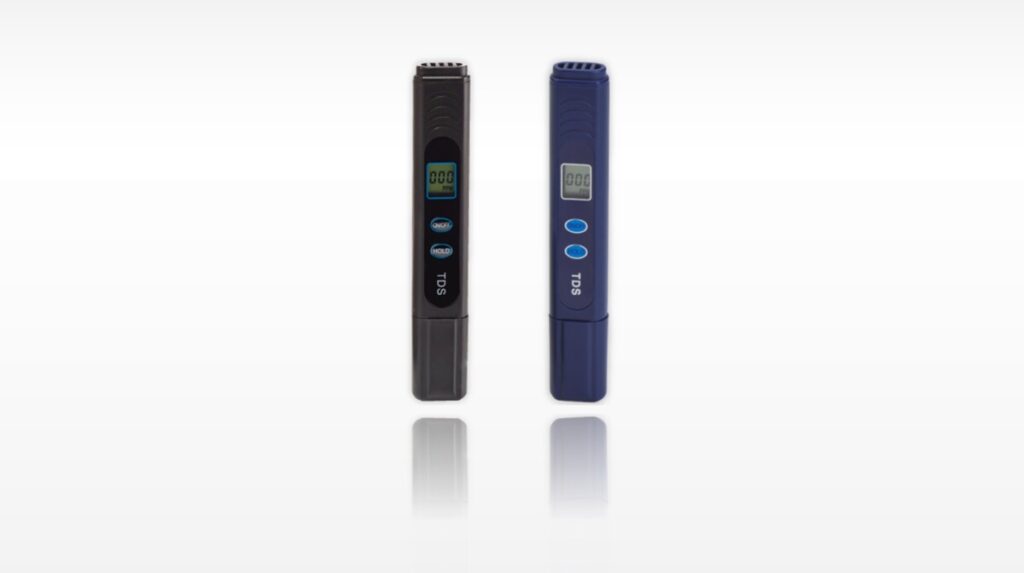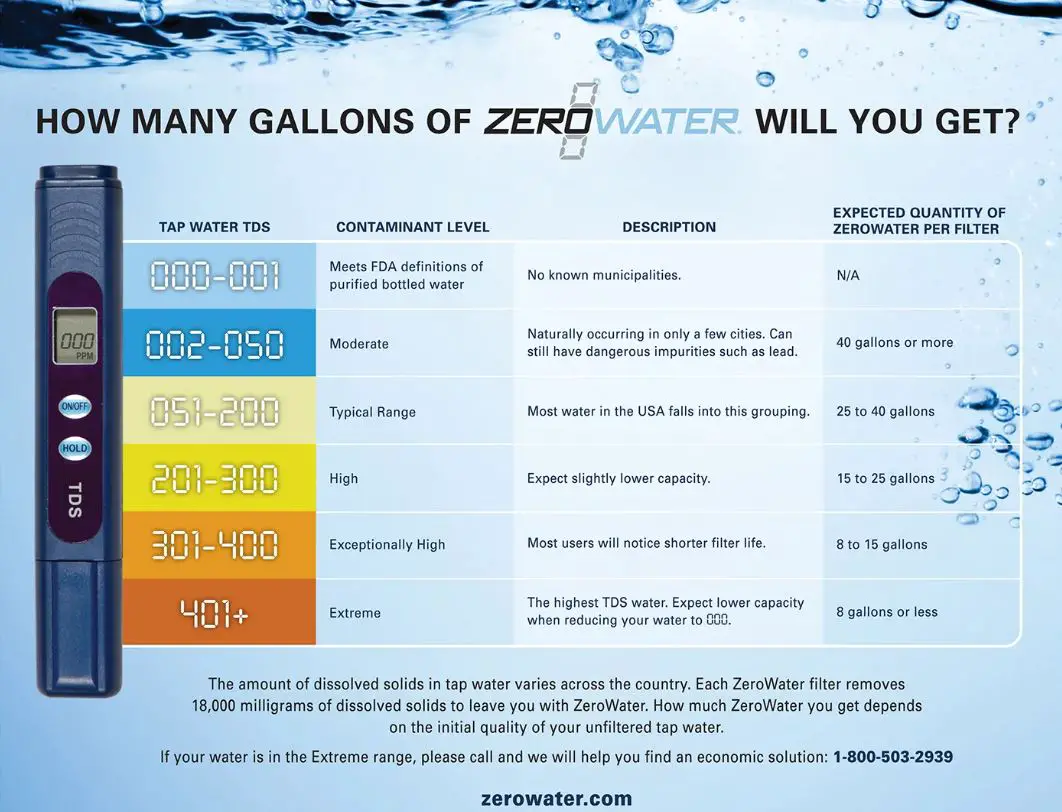It is important to filter your water to remove any unwanted contaminants from your water supply, and there are many options on the market. One of the ways to tell if your filter is working is through a TDS meter/tester, which ZeroWater provides with all its water filtration products.
The ZeroWater TDS meter is a simple and easy-to-use device designed to quickly measure the amount of Total Dissolved Solids (TDS) in any water body it is submerged into. It works by measuring the water’s conductivity, which is used as a proxy to work out the amount of total dissolved solids in the water.
Read on to find out how it works, what it measures, and how to use it correctly.

What it Measures
The ZeroWater TDS meter measures the amount of Total Dissolved Solids in any body of water it is placed into. These dissolved solids are any organic or inorganic particles or substances that can be found in a liquid. This accounts for most substances you would want to be removed from your drinking water.
However, the TDS meter does not measure everything.
Like most standard filters, such as PUR and Brita, the ZeroWater filter cannot remove viruses, bacteria, or other microorganisms from water. The TDS meter will also not be able to detect them.
Check out this article we wrote here that also includes everything ZeroWater filters can and cannot remove.
Most of the total dissolved solids in your water will be made up of salts, minerals, and some organic matter, which make up the bulk of material that ZeroWater filters claim to remove, such as Barium, Chlorine, and Asbestos.
According to ZeroWater, their TDS meter is not designed to measure the levels of Lead or PFOA/PFOS. It is also important to note that the TDS meter cannot inform you as to what pollutants or contaminants are actually in your water. This is because it is only capable of measuring the total number of dissolved solids, not distinguishing between distinct types such as copper ions or chlorine ions (for example).
How Accurate is the Meter?
As long as the meter is working correctly the ZeroWater TDS meter will be extremely accurate, and you can trust the number that you see on the screen.
However, the ZeroWater TDS meter can occasionally be prone to breaking or malfunctioning. This appears to be caused by the batteries inside, but other issues with electronic components in the meter can occur as well.
In this case, the ZeroWater TDS meter may give you incorrect readings on the TDS in your water – though it is more likely that it simply will not work at all.
Luckily, a new ZeroWater TDS meter is available to purchase on their website. Or even better, you contact ZeroWater’s customer support online or on 1-800-503-2939 and they should send you a new one, free of charge!
How To Use
To check your water’s TDS with ZeroWater TDS meter, you must first take off the cap at the end. Then, you simply need to press start, and submerge the end of the meter into the water.
Wait a couple of seconds, and a number should flash up on the digital screen at the other end of the ZeroWater TDS meter – this is the number of total dissolved solids that it has measured in Parts Per Million (PPM).
The ZeroWater TDS meter can be used to determine two things:
1. To ensure that the ZeroWater filter is actually working
- This is done simply by testing your tap water, and then your filtered water – if the ZeroWater meter is working and the filter has done its job, then the filtered water should have a significantly reduced TDS number.
2. To determine how much use you may be able to get out of your ZeroWater filter before it needs replacing.
- Once again this depends on the level of TDS in your tap water – an extremely high TDS level will mean the ZeroWater filter has to do more work purify your water, meaning it will last a shorter amount of time.
To see how many gallons of water you should expect to get out of your ZeroWater filter refer to this table:

This shows how many gallons of water ZeroWater believes their products will filter before needing to be replaced.
For the majority of people, at least in the USA, you can expect to filter anywhere between 25 – 40 Gallons, or 2 – 5 months’ worth of use.
As the ZeroWater filter becomes used, it will gradually become less effective. As such, you can expect to see the TDS measurement of your filtered water slowly go up over time.
ZeroWater recommends replacing your filter when the filtered water reads 006 TDS.
Why is my ZeroWater tester not working?
Electronics can often be prone to failure, and there are several reasons why you may find that your ZeroWater tester/meter is not working. The first thing you will want to do is troubleshoot the device in order to find out what the problem is.
- First, take off the cap and turn on the tester without submerging it in any water, and wait until it shows 000
- Next, leave the ZeroWater tester in a place that is at room-temperature for a while before attempting to use it again
- This is because the meter needs to be at room-temperature to function correctly. If the tester was stored in a cold place such as in the refrigerator with a pitcher, or an especially warm place, it will likely not work correctly.
If this does not fix the problem, the issue may well be dead, leaking, or faulty batteries – luckily, this is fairly simple and easy fix.
How do you change the battery in a ZeroWater tester?
To change the battery, all you will need is the correct replacement batteries. There are no screws, bolts, or other fittings, and you can simply slide the battery cartridge out.
- First, you will need the correct type of battery: ZeroWater TDS meters use 2 LR44 button cell batteries which can typically be found in general stores, DIY stores, Amazon, or anywhere that sells watch or hearing aid batteries
- Once you have the replacement batteries, remove the battery cap located at the end of the meter opposite from the testing stub. This should slide straight out, with the smooth, flat side (the positive side) of both batteries facing left
- Simply take these two out and replace them with new ones in the same position. It is important the new batteries are facing the correct way – the smooth, flat side which is the positive end of the battery facing left
- With this done correctly, you can gently slide the battery cap back in. It should fit back in smoothly within the tester stick
If this has not worked, there is likely something wrong with the electronics. At this stage you are best off contacting ZeroWater customer support and requesting a replacement, which they should provide free of charge.
How do I reset my ZeroWater tester?
Your ZeroWater tester should reset automatically whenever it is not in contact or submerged in water. However, there are some ways that may prevent the tester from automatically resetting like it should.
- On the tester stick there are only two buttons: an “on/off button” and a “hold” button
- By pressing the “hold” button, the figure displayed at the time of pressing will “lock,” meaning the tester will not instantly update its TDS number once removed from the water
- If you have pressed this button either on purpose or by accident, and wish for the tester to reset, you will need to press the “hold” button again, which should essentially “unlock” the tester, allowing it to automatically update again
- Equally, turning the ZeroWater tester off and on again should have the same effect of resetting the device
If neither of these solutions work, you can request a replacement tester from ZeroWater customer support.
